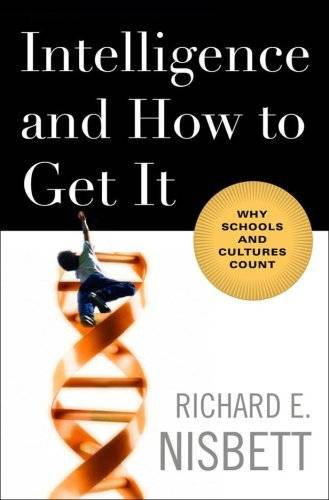 I suspect the vast majority of Americans feel roughly the same about IQ tests. We believe they measure something worth measuring, but we’re not sure what. We find broad, sweeping claims linking intelligence to ethnicity and race disturbing. Yet a new book on intelligence helps us understand what IQ tests measure-and their significance-and is not shy about discussing the IQs of various ethnic groups.
I suspect the vast majority of Americans feel roughly the same about IQ tests. We believe they measure something worth measuring, but we’re not sure what. We find broad, sweeping claims linking intelligence to ethnicity and race disturbing. Yet a new book on intelligence helps us understand what IQ tests measure-and their significance-and is not shy about discussing the IQs of various ethnic groups.
Intelligence and How to Get It: Why Schools and Cultures Count (W.W. Norton, hardcover, 282 pp. $26.95), by Richard E. Nisbett, empirical scientist and Distinguished University Professor at the University of Michigan, retains the validity of the concept of an IQ while asserting its malleability. This is a considerable feat.
Nisbett’s book works on several levels, but its main purpose is to argue that environment shapes IQ-a lot. While vigorously advancing his case, he is careful to include the findings of those who disagree with him. Why? Well, of course, as any high school debater knows, engaging the counterpoint strengthens the point. But another reason is because Nisbett wants educational debate to be informed by scientific rigor. He believes that controlled experiments-and other tools of empirical scientists-can help alleviate fear of associations with racism that surface when educators engage IQ tests; in turn, the quality of education can improve if educational policymakers take into account scientific knowledge of IQ.
Particularly in terms of its chapters on education (chapters three, four, and seven), Intelligence and How to Get It serves as a good introduction to the debate about IQ tests for laypeople. There is nothing predictable about Nisbett’s conclusions, which are often framed in terms of cost-effectiveness. He argues that directing more money into the system does not ensure better schools. He rejects common myths about teacher quality and class size, focusing on evidence to support renegade ideas, such as his claim that teacher quality is rarely linked to seniority or attainment of a Master’s degree-the criteria unions review when allocating raises. That influential ventures such as the Gates Foundation follow empirically informed educational practices should give us encouragement that ineffective policies may soon be replaced.
Chapter five outlines significant differences in parenting between social classes, noting, for example, that that the number of words lower-class parents expose their children to pales in comparison to the number upper-middle and middle-class parents speak to their children. Nisbett also notes other differences, such as the way higher social classes encourage critical thinking in their children while lower social orders often demand that their children follow directions.
As he contextualizes his arguments, Nisbett offers a crash course contrasting the history of blacks and the Irish in America (in chapter six), a study of the differences between Eastern and Western cultures (in chapter eight), an exploration of Jewish achievement (in chapter nine). Intelligence and How to Get It concludes with a sort of how-to manual providing advice to parents about how they can boost their offspring’s intelligence.
Opening with a list of facts showcasing Asian achievement, the chapter “Advantage Asia?” outlines the Asian motivation to achieve before more robustly discussing the differences between Asian and Western cultures. Consider this, Nisbett says: although the children of Indochinese boat people comprised only 20 percent of an enclave in Orange County, California, they claimed 12 of the 14 high school valedictorians. Pretty impressive. A personal anecdote enlivens the contrast. Nisbett tells of a Korean friend who defensively responds to the phrase “Asian overachievement” by wondering why people don’t invoke “American underachievement.” Point taken, perhaps, although I do believe the Puritan work ethic is alive and well.
Nisbett explains Asian drive in terms of Eastern interdependence: “If I am linked by strong bonds to my family, and fed its achievement demands along with my meals, I simply have no choice but to do my best in school and in professional life thereafter.” And, Nisbett continues, the fact that it is strength of will and hard work that lead to the accomplishment makes that expectation reasonable. I found this particularly interesting because I had always believed precisely the opposite-that a societal approach to life would make citizens less inclined to great achievement, because doing so would set them apart from others.
Overall, Nisbett emerges as eminently trustworthy. Intelligence and How to Get It references statistical terms much more frequently than my review suggests (and the book is also heavily annotated), yet this is not why the author gains our trust. Although he certainly approaches his subject from a liberal perspective-with the belief that culture and education influence IQ — Nisbett remains flexible, not tenacious, rigorous in his embrace of hard evidence in answering questions about intelligence, willing to change his mind as evidence demands. Luckily, he doesn’t need to.
As we read a smart book that remains within the grasp of people with no formal training in empirical research, we can feel good knowing that IQ can be influenced by the choices we make and what we do to help others.








